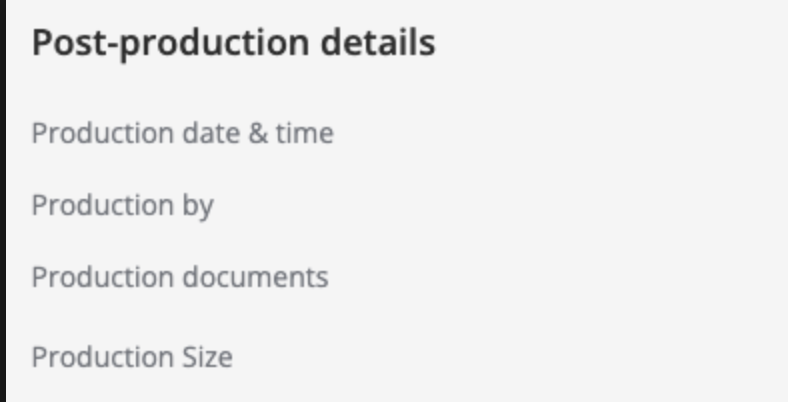⚡️ 1-Minute DISCO Download
Before coming to DISCO, I created and used legal timelines many times in the 15 years I practiced litigation. Even so, while consulting with our customers to develop DISCO’s Timelines feature, I learned a lot about how legal professionals around the world create and use their chronologies or timelines.
This article focuses on one aspect of how I believe legal timelines can be most efficiently organized: around facts, as opposed to documents.
But first, let’s discuss the importance of timelines and how they’re often used.
What I mean by “timelines”
“Timelines,” in this article, refers to the chronological listing of relevant facts and allegations (or events).
Some, including myself when I practiced, refer to that as a legal “chronology,” reserving “timelines” for the visual or graphical representation of events. However, we learned from our customers that the terms are often used interchangeably.
To that end, we chose “Timelines” to refer to our feature, and – spoiler alert! – leave open the possibility for a future visual representation of that data.
Legal timelines: When to use them
It is virtually impossible to overemphasize the importance of facts and evidence in the practice of law.
As we developed DISCO’s Timelines feature, our team analyzed the various ways a legal timeline might be used throughout the litigation process.
We put together this chart to try to understand some (but by no means all) of the usage:

This illustrates what is likely obvious to all legal practitioners – a timeline of events alleged in a lawsuit is relevant throughout a case, for the simple reason that the facts and allegations are always relevant.
This is true for an overarching understanding of the matter and strategy decisions, but also for specific tasks – such as understanding the context of documents during review, making objections to requests, preparing for and taking depositions, and preparing various motions.
Related: Get Your Deposition Right the First Time Using Topic Clustering with Automatic Indexing 📚
From the time you first speak with your client through trial, a legal timeline is the best vehicle for understanding and describing to others what happened.
However, organizing information can often be just as important (and challenging) as the information itself.
The big divide: Fact-centric vs. document-centric timelines
The traditional – and probably most common – approach for legal professionals is a document-centric approach to timelines.
However, there’s a growing trend in the legal community about the potential benefits of adopting a fact-centric approach to timeline organization.
Document-centric timelines are built around key documents such as contracts, emails, messages in various formats, or other computer files. They focus first on when these documents were created or received, and provide some information about those documents.
Related: Ediscovery Data Sources: How to Work with Collaborative Data 📚
A standard document-centric timeline (typically using Word or Excel) will have a column for the date, one column for sender/recipients or file information, another for “details” (these vary, but can be important selections from the document or other commentary about its importance), and a final column with Bates or other identification numbering.
In contrast, fact-centric timelines are organized around the facts or allegations of the case, regardless of when or if they were documented.
From the organizing principle of “facts” or events, one can build a timeline that cross-indexes documents (with associated commentary about each) or even anticipated evidence, and can also add information about relevant witnesses, issues, tasks, or other insights or tasks necessary related to those facts.
Related: 4 Tips for Leveraging Legal Technology for Evidence Management 📚
Why fact-centric timelines are the better alternative
Not every case team creates a timeline for every case.
Sometimes the facts are simple and straightforward. Possibly, they are undisputed. Even so, having a clear understanding of the facts is helpful for at least some aspect or task in a lawsuit.
When there’s value in understanding the facts, organizing a timeline by those facts has clear advantages over a document-based timeline.
(That’s not to say that a list of key documents that is annotated is not useful – it is. But it’s not a true substitute for a fact-based timeline, as I’ll show below).
Here are the 6 key advantages of a fact-based approach:
1. Fact-based timelines grant early insight
Fact-centric timelines can incorporate information or assertions that are known or suspected before any real documentation is in hand.
This early insight often comes from initial interviews with clients or other witnesses, or even from pleadings. By focusing on facts from the outset, legal teams can develop a more comprehensive understanding of the case from these sources, enabling them to strategize proactively rather than reactively.
From this baseline, a more fulsome timeline can be built or amended as evidence is uncovered in discovery.
2. Fact-based timelines capture undocumented facts
Legal matters often involve aspirational, uncertain, or simply undocumented facts.
For instance, a corporation’s clean safety record or the absence of prior investigations are facts that might not be captured in documents – but could be crucial to a case.
A fact-centric timeline (like DISCO’s, which allows “undated” facts) allows for including these intangible yet vital aspects of a case, which can be lost when documents are the sole focus.
Similarly, depositions and placeholders for witnesses are much easier to incorporate into a fact-based legal timeline. These can also incorporate statements (particularly the opposing party’s) in pleadings or other discovery as well.
Related: The Costs vs. Benefits of Using Deposition Videos in Your Cases 📚
3. Fact-based timelines keep the focus on what you’re proving – the facts
Ultimately, the success of a legal case hinges on the facts. While documents can be critical in proving or disproving alleged facts, they aren't what you are proving.
A fact-centric timeline emphasizes where the focus should be – on the facts themselves, using documents as supporting evidence rather than the primary focus.
4. Document dates can be misleading
Document-based dates can sometimes be misleading. The date on a document might not correspond to the date of the relevant fact it describes – such as an email recounting a past event or meeting.
This discrepancy can lead to confusion about the sequence of events, and even mask facts that are buried in incorrect “document” dates. A fact-centric approach aligns the timeline with the actual occurrence of events, providing a more precise and accurate chronology.
5. Fact-based timelines allow for clear visibility and intuitive organization
A fact-centric timeline makes it easier to group relevant documents and evidence under specific facts.
For example, a quarterly safety report might identify several incidents, each of which could in turn have additional relevant documents describing the details. Or a complaint or other legal filing might serve as a source for multiple facts or allegations.
A timeline based on facts makes these separate incidents easy to organize, and provides a space to include multiple pieces of supporting evidence nested under each.
By contrast, a document-based timeline where multiple events are simply included in the “details” of the various documents can bury the separate events and lead to confusion.
6. Fact-based timelines bring disputed facts into sharper focus
The fact-centric approach to a timeline also brings disputed facts into sharper focus. A document’s authenticity might not be questioned in a document-centric timeline, but the contents could be highly disputed.
A fact-centric timeline brings these disputes to the forefront, allowing for a more direct address.
At DISCO, we understand the pivotal role that effective timeline management plays in legal success. That’s why we’ve developed a cutting-edge solution tailored to modern law firms’ needs. Here’s a peek at how our software centers on facts, then permits tagging and notes, as well as associating the facts with witnesses or (any) evidence:

💡 Learn more: DISCO Timelines overview
The truth about document-centric timelines
Interestingly, many document-centric timelines are, in essence, fact-based timelines in disguise.
For example, they often cross-reference multiple documents under single entries, which can obscure the facts. This approach can lead to confusion and inefficiency, as the real issues may be buried under layers of “notes” about the documents.
It’s important to note that fact-centric timelines enhance the ability to use documents in legal practice. Documents are critical, and their value is maximized when they are used as evidence within a fact-based framework. This approach allows legal teams to leverage documentation effectively while keeping the spotlight on the facts that drive the case.
The strategic shift to fact-centric timelines
Adopting a fact-centric timeline offers numerous advantages for legal teams. It promotes early and comprehensive case understanding, accommodates intangible yet crucial facts, and provides clarity and focus by aligning the timeline with the actual events.
By shifting to this approach, law firms can enhance their strategic capabilities, leading to more effective case management and successful outcomes.
How information is organized in the dynamic and often complex legal landscape can significantly impact a case’s trajectory. A fact-centric timeline is not just a method of organization; it’s a strategic tool that empowers legal teams to navigate their cases with greater precision and insight.
Though legal professionals do understand the advantages (though perhaps have not had the time to catalog them!) one obstacle to their pervasive use is likely the lack of technological solutions that are easy to create and maintain.
How to build a fact-based legal timeline
Building a fact-based legal timeline isn’t complicated, but it does require a shift in mindset from traditional, document-centric approaches. The goal is to focus on what actually happened, then layer in the supporting evidence. Here’s how.
1. Identify the key facts
Start by listing out the critical facts of the case. These might come from pleadings, interviews, depositions, etc. Some key types of facts include:
- Alleged events in the case
- Statements from parties or witnesses
- Significant interactions, meetings, or decisions
If a fact is relevant but undated for now, don’t worry – leave it undated for now. The priority is capturing what happened.
2. Arrange facts in a chronological order
Once the key facts are identified, begin to put them in order of when they actually happened. This avoids the common pitfall of mistaking when a document about an event was created vs. when the event actually happened. For example, an email recounting a conversation from three days prior doesn’t belong on the timeline under the email’s timestamp. It belongs with the actual conversation.
When exact dates aren’t known, placeholders can be used (i.e. “Late 2024” or “April 2021”). This flexibility is one of the key advantages of a fact-based timeline.
3. Connect supporting documents
With the factual framework in place, link documents and other evidence to each fact rather than letting documents dictate the timeline structure. This might include:
- Emails, contracts, or memos verifying an event
- Witness testimony supporting or disputing a fact
- Multimedia evidence like video or audio files
4. Tag witnesses and legal issues
Tagging each fact with things like relevant witnesses and issues makes the timeline even more useful, allowing teams to:
- Quickly see which witnesses can speak to which facts
- Filter facts based on claims, defenses, or legal issues
- Prepare for depositions, motions, or trial with a clear factual breakdown
This turns a well-organized timeline from just a list to a strategic tool for case preparation.
5. Keep it dynamic
A fact-based timeline isn’t a static document. It should evolve as discovery progresses and new evidence emerges. This means regularly updating it by:
- Adding new facts uncovered in depositions or doc review
- Refining the sequence of events as more details come to light
- Highlighting disputed facts for deeper analysis
Your timeline should grow alongside the case, rather than requiring you to overhaul it repeatedly.
6. Level visualization tools
While the primary goal is to build a solid, fact-driven foundation, visualizing the timeline can provide additional insights. Graphical representations, interactive tags, or linking facts to key documents can reveal patterns, gaps, or contradictions that might not be as obvious in a text-based list.
Creating fact-based legal timelines with DISCO
DISCO Timelines is an innovative new solution set that equips case teams with a collaborative and secure workspace where they can organize all facts and evidence throughout the life of a matter and ultimately, build a more powerful story of the case.
Case teams are using Timelines to:
- Organize all of their evidence to build the most compelling case narrative: Easily create a timeline that tells the most compelling story of the case. Add supporting evidence, tag issues, and incorporate witnesses seamlessly to make the timeline a powerful tool for building a winning case strategy.
- Keep all your critical information up to date in one singular location where your entire team can work together: Work together in the same timeline, in real-time, throughout the life of your matter. Ensure that everyone is always up-to-date with the most recent information – and that no key information falls through the cracks.
- Strengthen your case by including evidence from anywhere: Hyperlink evidence to facts no matter where that evidence lives, be it in documents or excerpts in ediscovery or depositions, or even on the Internet.
- Search across facts by importance, witness association, disputed status, words or phrases, and more, in seconds: Find the information you need when you need it.
DISCO Timelines continues to support case teams in moving toward a single dispute management platform where they can work collaboratively and efficiently throughout the litigation and investigation lifecycles. With Timelines, case teams gain a full perspective of their case and build stronger case strategies faster.
Update: DISCO brings generative AI technology to legal chronologies with Cecilia
Timelines are just one of the ways that DISCO makes fact management and deposition review faster and easier for legal professionals. Want to see how we can transform your practice? Request a demo.
More by Scott Upchurch:
- The Costs vs. Benefits of Using Deposition Videos in Your Cases
- Get Your Deposition Right the First Time Using Topic Clustering with Automatic Indexing






%20(1).jpeg)








